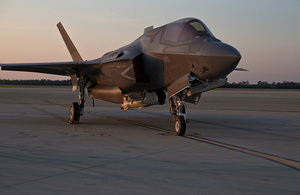Strategic Defence and Security Review: £178bn of equipment spending
The 2015 review analysed the full range of threats and examined the capabilities needed to counter them

F-35B Lightning II. Crown Copyright.
The review promises nine new maritime patrol aircraft for surveillance, two new Army strike brigades, an additional F-35 Lightning II squadron, and extending the service of Typhoon jets by 10 years through to 2040.
Today (November 23) the Strategic Defence and Security Review (SDSR) has been published, outlining investment in the RAF, Navy and Army to deter threats, protect the UK and its allies, and improve the ability to respond to crises.
The MOD will spend £178 billion on equipment over the next decade, an increase of £12 billion on previous plans. The Defence budget will increase by 0.5% above inflation for the rest of this Parliament allowing investment in people, equipment and the MOD estate.
The MOD will be able to deploy a potent, expeditionary force of around 50,000, based on a land division, maritime task group and expeditionary air group. Joint Force 2025 will be a more capable force to meet the challenges of today and ready for those of tomorrow.
The risks and threats faced by the UK have increased in scale, diversity and complexity since the last SDSR in 2010. Russia’s resurgence, the increasing cyber threat, instability in the Middle East and North Africa, and the growing threat of international terrorism illustrate how the challenge has evolved. Defence is continuing to adapt to meet these growing threats and the MOD is investing heavily in the capabilities required to respond quickly and effectively.
The combat power of the RAF will be expanded; we will maintain our plan to buy 138 F-35 Lightning II aircraft over the life of the programme and deliver 24 front line aircraft by 2023. Two additional Typhoon squadrons will also be created. There will also be a new fleet of Protector intelligence surveillance and reconnaissance armed remotely piloted aircraft and a fleet of P-8 Maritime Patrol Aircraft, with an overland surveillance capability.
The first of the Royal Navy’s new aircraft carriers, the HMS Queen Elizabeth, will enable initial aircraft carrier strike operating capability in 2020. The River Class Offshore Patrol vessels fleet will be replaced with a modern and more capable variant. The Navy will operate 19 destroyers and frigates, new Type 26 Global Combat Ships will enter service from the mid-2020s while maritime helicopters will continue to be upgraded.
The Army size will be retained and reconfigured to have two armoured infantry brigades and two new rapid-reaction strike brigades. A number of infantry battalions will also provide specialist training and assistance to allies, including for counter-terrorism.
Speaking earlier today, Defence Secretary Michael Fallon said:
On equipment, we’re spending some £12 billion more than we originally planned. We’re spending £178 billion - that means more ships, more planes, more equipment for the Special Forces.
The defence budget as a whole, for the first time in some years, is going to start increasing from April and every year of this Parliament. We’ll be spending more money on keeping our country safe.
There will also be greater investment in defence intelligence, cyber capabilities, Special Forces equipment and interoperability with allies to support better and faster decision-making.
The MOD will modernise arrangements for Service personnel by introducing flexible terms of working, a new accommodation offer to help them live in private accommodation or own their own homes, and a new offer for recruits will meet the needs of individuals and Defence.
By protecting the nation and building international stability, Defence also makes a key contribution to economic security and prosperity.
To read the full SDSR, click here